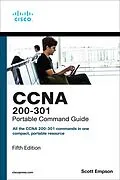CCNA 200-301 Portable Command Guide is filled with valuable, easy-to-access information-and it's portable enough to use whether you're in the server room or the equipment closet.
The guide summarizes all CCNA certification-level Cisco IOS Software commands, keywords, command arguments, and associated prompts, providing you with tips and examples of how to apply the commands to real-world scenarios. Throughout, configuration examples give you a better understanding of how these commands are used in simple network designs.
This book has been completely updated to cover topics in the new 200-301 exam. Use this quick reference resource to help you memorize commands and concepts as you work to pass the CCNA certification exam. Coverage includes
· Network Fundamentals: IPv4 addressing, subnetting, VLSM, route summarization, IPv6 addressing, cables/connections, CLI
· LAN Switching Technologies: Switch configuration, VLANs, VLAN trunking protocol, inter-VLAN communication, STP, EtherChannel, CDP, LLDP
· Routing Technologies: Router configuration, static routing, OSPF
· IP Services: DHCP, NAT, NTP
· Security Fundamentals: Layer 2 security, ACL traffic management, device monitoring and hardening
· Wireless Technologies: Configuring and securing a WLAN AP
· Quick, offline access to all CCNA commands for research and solutions
· Logical how-to topic groupings for a one-stop resource
· Great for review before CCNA certification exams
· Compact size makes it easy to carry with you wherever you go
· "Create Your Own Journal" section with blank, lined pages enables you to personalize the book for your needs
This book is part of the Cisco Press Certification Self-Study Product Family, which offers readers a self-paced study routine for Cisco certification exams. Titles in the Cisco Press Certification Self-Study Product Family are part of a recommended learning program from Cisco that includes simulation and hands-on training from authorized Cisco Learning Partners and self-study products from Cisco Press.
Autorentext
Scott Empson is an instructor in the Department of Information Systems Technology at the Northern Alberta Institute of Technology in Edmonton, Alberta, Canada, where he has taught for more than 20 years. He teaches technical courses in Cisco routing and switching, along with courses in professional development and leadership. He has a Master of Education degree along with three undergraduate degrees: a Bachelor of Arts, with a major in English; a Bachelor of Education, again with a major in English/language arts; and a Bachelor of Applied Information Systems Technology, with a major in network management. Scott lives in Edmonton, Alberta, with his wife, Trina, and two university-attending-but-still-haven't-moved-out-yet-but-hope-to-move-out-as-soon-aspossible-after-graduation-so-Dad-can-have-the-TV-room-back children, Zachariah and Shaelyn.
Inhalt
- CHAPTER 1 IPv4 Addressing-How It Works
- CHAPTER 2 How to Subnet IPv4 Addresses
- CHAPTER 3 Variable Length Subnet Masking (VLSM)
- CHAPTER 4 Route Summarization
- CHAPTER 5 IPv6 Addressing-How It Works
- CHAPTER 6 Cables and Connections
- CHAPTER 7 The Command-Line Interface
- CHAPTER 8 Configuring a Switch
- CHAPTER 9 VLANs
- CHAPTER 10 VLAN Trunking Protocol and Inter-VLAN Communication
- CHAPTER 11 Spanning Tree Protocol
- CHAPTER 12 EtherChannel
- CHAPTER 13 Cisco Discovery Protocol (CDP) and Link Layer Discovery Protocol (LLDP)
- CHAPTER 14 Configuring a Cisco Router
- CHAPTER 15 Static Routing
- CHAPTER 16 Open Shortest Path First (OSPF)
- CHAPTER 17 DHCP
- CHAPTER 18 Network Address Translation (NAT)
- CHAPTER 19 Configuring Network Time Protocol (NTP)
- CHAPTER 20 Layer Two Security Features
- CHAPTER 21 Managing Traffic Using Access Control Lists (ACLs)
- CHAPTER 22 Device Monitoring and Hardening
- CHAPTER 23 Configuring and Securing a WLAN AP
- APPENDIX A How to Count in Decimal, Binary, and Hexadecimal
- APPENDIX B How to Convert Between Number Systems
- APPENDIX C Binary/Hex/Decimal Conversion Chart
- APPENDIX D Create Your Own Journal Here
